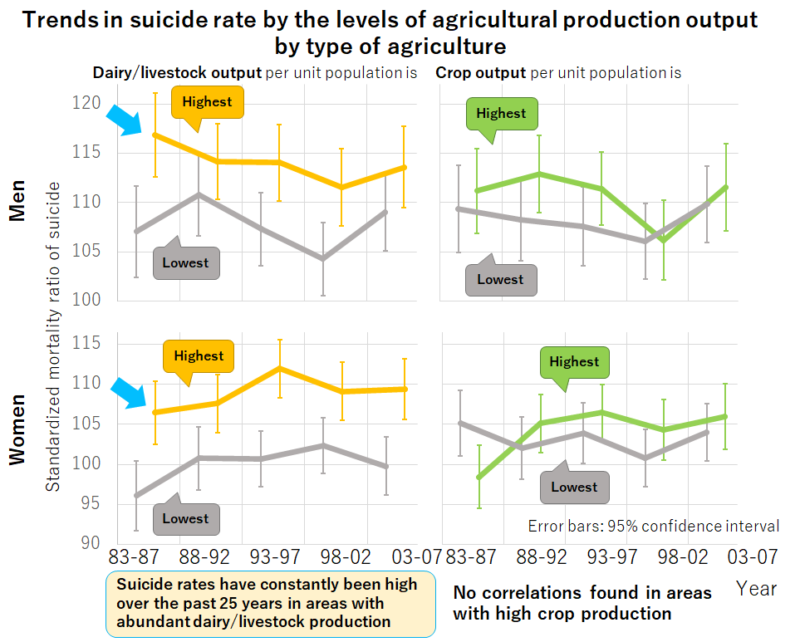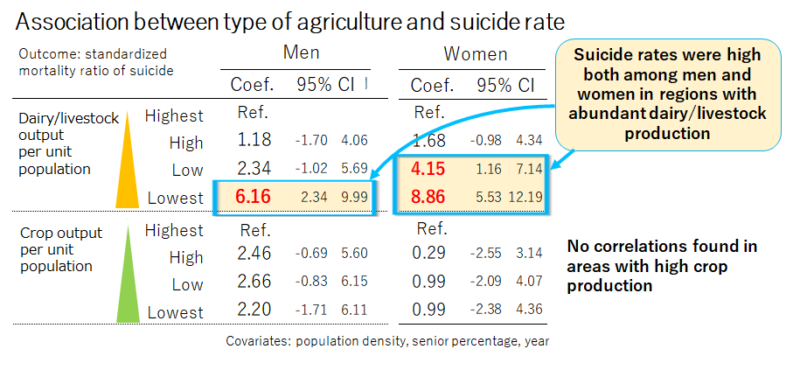Consistent trends over the past 25 years
Causes such as overwork and lack of support need to be elucidated
Higher suicide rates have been reported in rural areas than in urban areas, but no differences between different types of agriculture have been reported. This study used government-published data to compare suicide rates of municipalities with active dairy/livestock farming and those with active crop farming. Results showed that suicide rates were higher in regions with high dairy/livestock output than in those with low output. These trends were seen in both men and women, and have not changed over the past 25 years. Regional characteristics such as history, culture, and working style differed according to the type of agriculture common in the region. Individuals in regions with high dairy/livestock output may struggle to seek help or may work in physically and/or mentally burdensome conditions. The results suggest that further investigations should be conducted to clarify the causes and that suicide prevention measures should be implemented.

The amount of actual dairy/livestock production was analyzed by dividing it into four levels: “high,” “somewhat high,” “somewhat low,” and “low.” Only “high” and “low” are shown here for clarity.
Background
Higher suicide rates have been reported in rural areas than in urban areas. However, limited studies have investigated the kinds of regional environments in rural areas that may be associated with suicide rates. Regions vary in terms of work content, working styles, and history according to the type of agriculture that is common in them, including rice farming, vegetables, dairy farming, and livestock farming. Japanese agriculture has changed drastically since the period of high economic growth due to the westernization of dietary habits, development of production technology, and globalization of the crop market. However, the impact on the health of the people in the production areas may have differed depending on the type of agriculture common in the region. Therefore, we focused on the types of agriculture common in the region and analyzed their relationships with the suicide rate by municipality in Japan.
Methods
- We selected and analyzed 404 municipalities considered to have strong agricultural characteristics from all municipalities across Japan based on the “Agricultural Region Type Classification” by the Ministry of Agriculture, Forestry, and Fisheries.
- The following data were used to perform a multi-level analysis that considered the hierarchical structure of the time-series data.
- Data for “standardized mortality ratio of suicide” prepared by the Comprehensive Suicide Prevention Measures Center, which adjusts for differences in age composition of each municipality. Data from 25 years were used (from 1983 to 2007).
- The data of crop output by agricultural sector from the production/agricultural income statistics of the Ministry of Agriculture, Forestry, and Fisheries were categorized into “dairy/livestock” and “crops,” and these were used for the analysis of “dairy/livestock output per unit population” and “crop output per unit population,” which were divided by the population of the municipality. Data from the same time period as those of the suicide rates were used.
- Results were adjusted for effects of population density, senior percentage, and fiscal year.
Results

Municipalities with high “dairy/livestock output per unit population” had a statistically significantly higher suicide rate among both men and women. The coefficients in the figure indicate the number of points by which the standardized mortality ratio of suicide is higher than that in municipalities with “low” output. A stronger correlation was found among women than among men. No statistically significant relationships were seen for crop output.
Furthermore, regions with high dairy/livestock output from 1983 to 2007 were shown to have a consistently higher suicide rate among both men and women (opening figure). Regions with high crop output did not show such trends.
Conclusion
The results suggested that abundant dairy/livestock production was associated with suicide rates in a region. Regions with abundant dairy/livestock production may include many dairy and livestock farmers as well as people from other occupations who find it difficult to seek help or may work in physically and/or mentally burdensome conditions. The results suggest that further investigations should be conducted to clarify the causes, and that suicide prevention measures should be implemented.
Published paper
Mariko Kanamori, Naoki Kondo. Suicide and Types of Agriculture: A Time-Series Analysis in Japan. Suicide and Life-Threatening Behavior. June 2019. https://doi.org/10.1111/sltb.12559 (OpenAccess)
Acknowledgments
Mariko Kanamori received research grants from the Graduate Program for Social ICT Global Creative Leaders (GCL) of the University of Tokyo and the Japan Society for the Promotion of Science. Naoki Kondo received research grants from the Japan Society for the Promotion of Science (KAKENHI Grant No. JP18H04071) and the Research and Development Grants for Longevity Science from the Japan Agency for Medical Research and Development (AMED: 17dk0110027h001).


コメント